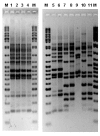Legionnaires' disease outbreak in Murcia, Spain
- PMID: 12967487
- PMCID: PMC3020623
- DOI: 10.3201/eid0908.030337
Legionnaires' disease outbreak in Murcia, Spain
Abstract
An explosive outbreak of Legionnaires' disease occurred in Murcia, Spain, in July 2001. More than 800 suspected cases were reported; 449 these cases were confirmed, which made this the world's largest outbreak of the disease reported to date. Dates of onset for confirmed cases ranged from June 26 to July 19, with a case-fatality rate of 1%. The epidemic curve and geographic pattern from the 600 competed epidemiologic questionnaires indicated an outdoor point-source exposure in the northern part of the city. A case-control study matching 85 patients living outside the city of Murcia with two controls each was undertaken to identify to outbreak source; the epidemiologic investigation implicated the cooling towers at a city hospital. An environmental isolate from these towers with an identical molecular pattern as the clinical isolates was subsequently identified and supported that epidemiologic conclusion.
Figures




Similar articles
-
Epidemiological investigation and case-control study: a Legionnaires' disease outbreak associated with cooling towers in Warstein, Germany, August-September 2013.Euro Surveill. 2015;20(46). doi: 10.2807/1560-7917.ES.2015.20.46.30064. Euro Surveill. 2015. PMID: 26607018
-
Community outbreak of Legionnaires' disease: an investigation confirming the potential for cooling towers to transmit Legionella species.Clin Infect Dis. 1996 Feb;22(2):257-61. doi: 10.1093/clinids/22.2.257. Clin Infect Dis. 1996. PMID: 8838181
-
Outbreak of Legionnaires' disease among cruise ship passengers exposed to a contaminated whirlpool spa.Lancet. 1996 Feb 24;347(9000):494-9. doi: 10.1016/s0140-6736(96)91137-x. Lancet. 1996. PMID: 8596266
-
Epidemiology and clinical management of Legionnaires' disease.Lancet Infect Dis. 2014 Oct;14(10):1011-21. doi: 10.1016/S1473-3099(14)70713-3. Epub 2014 Jun 23. Lancet Infect Dis. 2014. PMID: 24970283 Review.
-
Legionnaires' disease in France.Med Mal Infect. 2015 Mar;45(3):65-71. doi: 10.1016/j.medmal.2015.01.015. Epub 2015 Feb 24. Med Mal Infect. 2015. PMID: 25722040 Review.
Cited by
-
Legionnaires' disease from a cooling tower in a community outbreak in Lidköping, Sweden- epidemiological, environmental and microbiological investigation supported by meteorological modelling.BMC Infect Dis. 2012 Nov 21;12:313. doi: 10.1186/1471-2334-12-313. BMC Infect Dis. 2012. PMID: 23171054 Free PMC article.
-
Street Cleaning Trucks as Potential Sources of Legionella pneumophila.Emerg Infect Dis. 2017 Nov;23(11):1880-1882. doi: 10.3201/eid2311.161390. Emerg Infect Dis. 2017. PMID: 29048281 Free PMC article.
-
Infectious Diseases Society of America/American Thoracic Society consensus guidelines on the management of community-acquired pneumonia in adults.Clin Infect Dis. 2007 Mar 1;44 Suppl 2(Suppl 2):S27-72. doi: 10.1086/511159. Clin Infect Dis. 2007. PMID: 17278083 Free PMC article. No abstract available.
-
Legionellosis outbreak associated with asphalt paving machine, Spain, 2009.Emerg Infect Dis. 2010 Sep;16(9):1381-7. doi: 10.3201/eid1609.100248. Emerg Infect Dis. 2010. PMID: 20735921 Free PMC article.
-
Value of serological testing for diagnosis of legionellosis in outbreak patients.J Clin Microbiol. 2005 Aug;43(8):4022-5. doi: 10.1128/JCM.43.8.4022-4025.2005. J Clin Microbiol. 2005. PMID: 16081945 Free PMC article.
References
-
- Breiman RF. Impact of technology on the emergence of infectious diseases. Epidemiol Rev. 1996;18:4–9. - PubMed
-
- Ishimatsu S, Hiroshi M, Hori H, Tanaka Y, Yoshida SI. Sampling and detection of Legionella pneumophila aerosols generated from an industrial cooling tower. Ann Occup Hyg. 2001;45:421–7. - PubMed
MeSH terms
LinkOut - more resources
Full Text Sources
Medical
